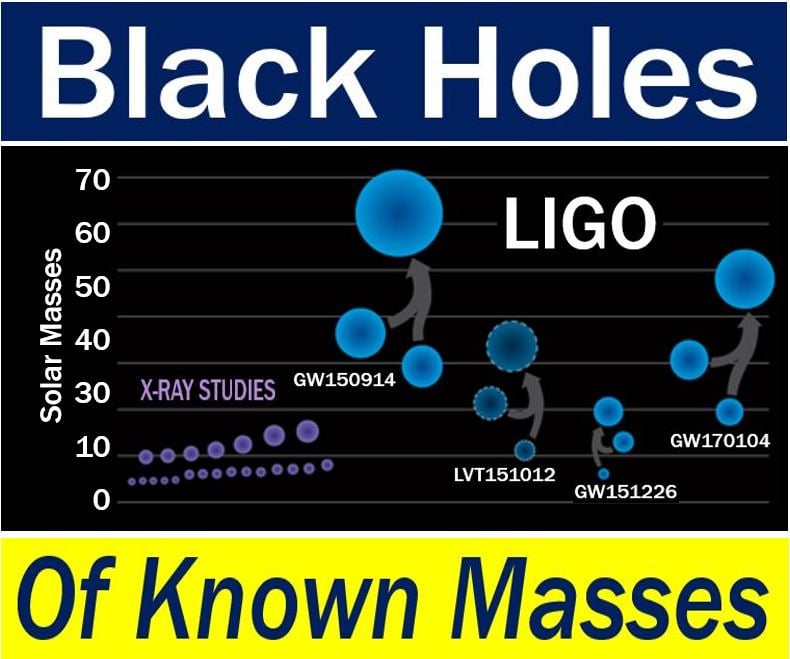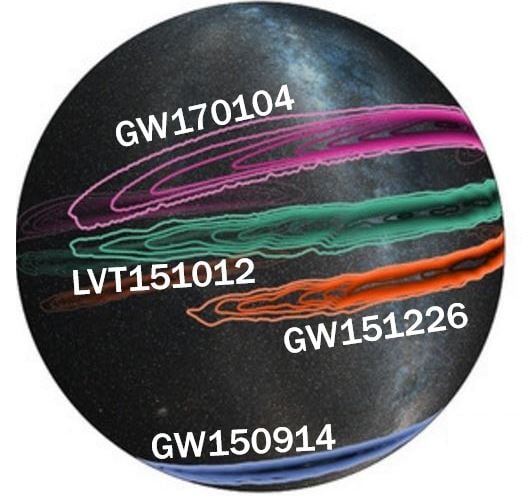Gravitational waves have been detected in space for the third time, say scientists from the LIGO Scientific and Virgo Collaboration. Gravitational waves are ripples in the fabric of space that cause space to stretch and squeeze back again. Scientists have long believed that accelerating masses should send gravity waves into space.
Scientists from the LIGO Scientific and Virgo Collaboration say their finding demonstrates that a new window in astronomy has now been firmly opened. LIGO stands for Laser Interferometer Gravitational-wave Observatory.
LIGO is an international collaboration with members across the world. Its observations are made by two detectors – one in Livingston Louisiana, and the other in Hanford, Washington. They are operated by MIT and Caltech, with funding from the National Science Foundation.
As occurred during the first two detections of gravitational waves, the researchers explained in an article published in the Physical Review Letters journal, published 1 June, 2017, and titled – ‘GW170104: Observation of a 50-Solar-Mass Binary Black Hole Coalescence at Redshift 0.2‘ – the waves were generated when a pair of black holes collided and formed a larger one.
 An artist’s impression of two merging black holes similar to the ones LIGO detected. They are spinning in a non-aligned fashioned, i.e. they have different orientations relative to their orbital motion. (Image: science.mit.edu)
An artist’s impression of two merging black holes similar to the ones LIGO detected. They are spinning in a non-aligned fashioned, i.e. they have different orientations relative to their orbital motion. (Image: science.mit.edu)
This third detection, which was made on January 4th, 2017, is called GW170104.
Supermassive black hole is huge
The supermassive black hole, which was formed when two smaller ones merged, has forty-nine times the mass of our Sun. In the first detection of gravitational waves, the black hole had a mass of 62 suns, and 21 in the second detection.
David Shoemaker, from the MIT Kavli Institute, the newly-elected LIGO Scientific Collaboration spokesperson, said:
“We have further confirmation of the existence of stellar-mass black holes that are larger than 20 solar masses – these are objects we didn’t know existed before LIGO detected them.”
“It is remarkable that humans can put together a story, and test it, for such strange and extreme events that took place billions of years ago and billions of light-years distant from us. The entire LIGO and Virgo scientific collaborations worked to put all these pieces together.”
This latest detection happened during LIGO’s current observing run, which started on November 30th last year, and will continue until the end of the summer of 2017.
Three gravitational waves had similar causes
In every case, each of the LIGO detectors spotted gravitational waves from the hugely energetic mergers of pairs of black holes.
 LIGO has detected a new population of black holes with masses considerably larger than what had been discovered before with X-ray studies alone. Caltech writes: “The three confirmed detections by LIGO (GW150914, GW151226, GW170104), and one lower-confidence detection (LVT151012), point to a population of stellar-mass binary black holes that, once merged, are larger than 20 solar masses – larger than what was known before.” (Image: adapted from caltech.edu/news)
LIGO has detected a new population of black holes with masses considerably larger than what had been discovered before with X-ray studies alone. Caltech writes: “The three confirmed detections by LIGO (GW150914, GW151226, GW170104), and one lower-confidence detection (LVT151012), point to a population of stellar-mass binary black holes that, once merged, are larger than 20 solar masses – larger than what was known before.” (Image: adapted from caltech.edu/news)
These types of collisions produce more power than all the stars and galaxies in the Universe radiate at any given time.
This last detection, located approximately 3 billion miles from Earth, is the farthest one so far. The first detection was 1.3 billion miles away, and the second one 1.4 billion miles.
Black holes spin in any direction
In this latest observation, scientists say they had some clues regarding the directions in which the pair of black holes were spinning. As two black holes spiral around each other, they spin on their own axes – imagine two ice skaters circling around each other while at the same time spinning individually.
In some cases, the two black holes spin in the same overall orbital direction as the pair is moving – what scientists refer to as aligned spins. On other occasions, they spin in the opposite direction of their orbital motion.
Black holes can even be tilted away from the orbital plane. Put simply, black holes can spin in any direction.
After gathering and analyzing data from the latest observation, scientists have been unable to determine whether the black holes were tilted. However, the data implied that at least one of them may have been non-aligned compared to its (their) overall orbital motion.
LIGO needs to make more observations before anything definitive can be said regarding the spins of binary black holes. These early data do offer some clues about how these pairs of black holes may form.
 This 3-dimensional projection of our galaxy (Milky Way) onto a transparent globe shows where the three confirmed LIGO black-hole merger events probably took place. (LVT151012 is a possible detection, at lower significance). (Image: caltech.edu)
This 3-dimensional projection of our galaxy (Milky Way) onto a transparent globe shows where the three confirmed LIGO black-hole merger events probably took place. (LVT151012 is a possible detection, at lower significance). (Image: caltech.edu)
How are black hole pairs formed?
Co-author Bangalore Sathyaprakash, of Penn State in the USA and Cardiff University in Wales, said:
“This is the first time that we have evidence that the black holes may not be aligned, giving us just a tiny hint that binary black holes may form in dense stellar clusters.”
Two primary models are used to explain how binary pairs of black holes are formed:
– Born Together: they are formed when each star in a pair of stars explodes. As the original stars were spinning in alignment, the black holes probably remain aligned.
– They Pair Up Later: black holes are not born together – this occurs later in life within crowded stellar clusters. After two black holes sink to the center of a star cluster, they pair up. In this scenario, scientists believe, the two black holes might spin in any direction relative to their orbital motion.
As LIGO sees some evidence that the black holes in this latest finding of gravitational waves were non-aligned, the researchers favor the dense stellar cluster theory.
Co-author Keita Kawabe, from Caltech in California, who is based at the LIGO Hanford Observatory, said:
“We’re starting to gather real statistics on binary black hole systems. That’s interesting because some models of black hole binary formation are somewhat favored over the others even now and, in the future, we can further narrow this down.”
Reconstructing the #GW170104 #GravitationalWave signal seen by @LIGOLA and @LIGOWA – adapted from Fig 4 in https://t.co/96K1GLeB7Y pic.twitter.com/1VQuYCkHD5
— LIGO (@LIGO) June 2, 2017
Testing Einstein’s theories
This study once again puts some of Albert Einstein’s theories to the test. The scientists looked for an effect known as dispersion, which happens when light waves in glass – or any physical medium – travel at different speeds depending on their wavelength; prisms create rainbows in this way.
According to Einstein’s general theory of relativity, dispersion in gravitational waves is not possible because they propagate from their source to the Earth. LIGO found no evidence of this effect.
Co-author, Laura Cadonati, from Georgia Tech in the USA, said:
“It looks like Einstein was right—even for this new event, which is about two times farther away than our first detection. We can see no deviation from the predictions of general relativity, and this greater distance helps us to make that statement with more confidence.”
Co-author, Jo van den Brand, from the Dutch National Institute for Subatomic Physics (Nikhef), who is also a professor at VU University in Amsterdam, said:
“The LIGO instruments have reached impressive sensitivities. We expect that by this summer Virgo, the European interferometer, will expand the network of detectors, helping us to better localize the signals.”
The team members are continuing to search LIGO data for signs of gravitational waves from billions of miles away in space. In LIGO’s next run, scheduled to start in late 2018, its sensitivity will be improved. Scientists are currently working on technical upgrades.
Co-author David Reitze, from Caltech, executive director of the LIGO Laboratory, said:”
“With the third confirmed detection of gravitational waves from the collision of two black holes, LIGO is establishing itself as a powerful observatory for revealing the dark side of the universe.”
“While LIGO is uniquely suited to observing these types of events, we hope to see other types of astrophysical events soon, such as the violent collision of two neutron stars.”
Video – Gravitational Waves
This Max-Planck Institute video shows the gravitational waves caused by the merger of two black holes. The strength of the gravitational wave is indicated by color as well as elevation. Blue indicates weak fields, and yellow strong fields.
